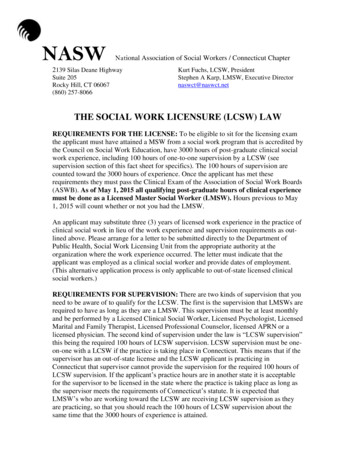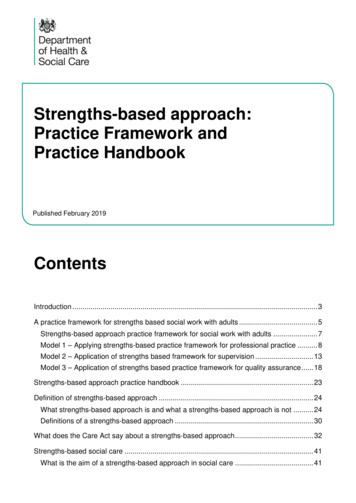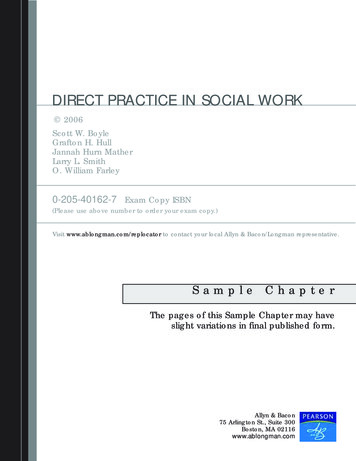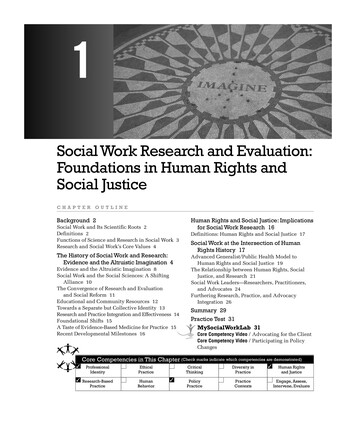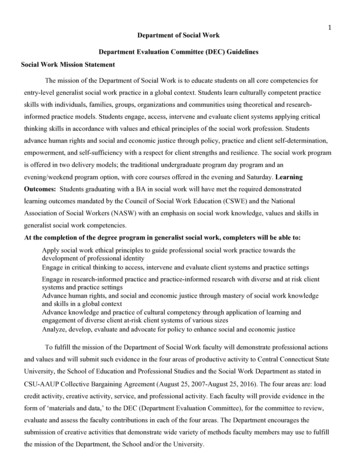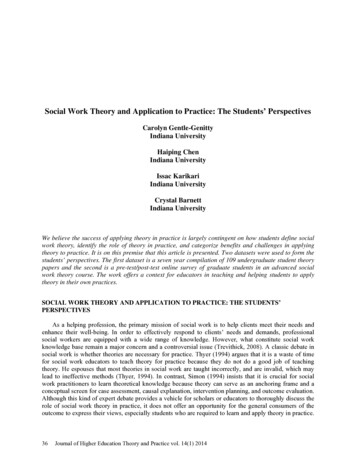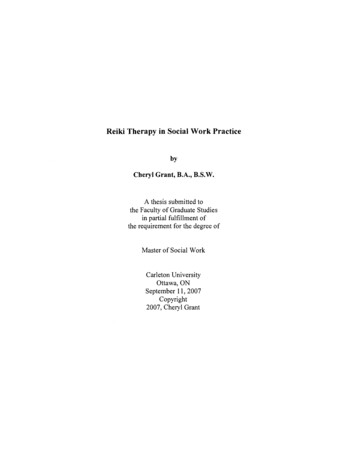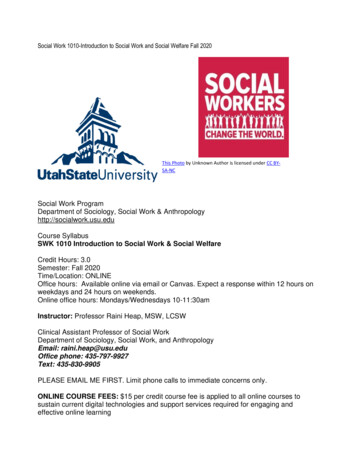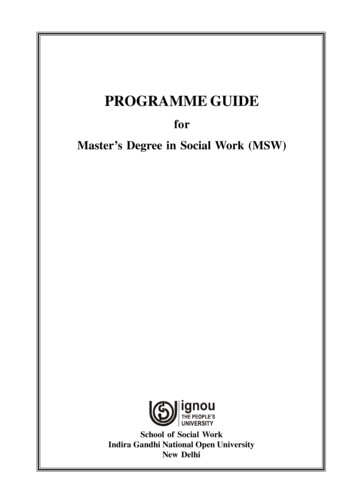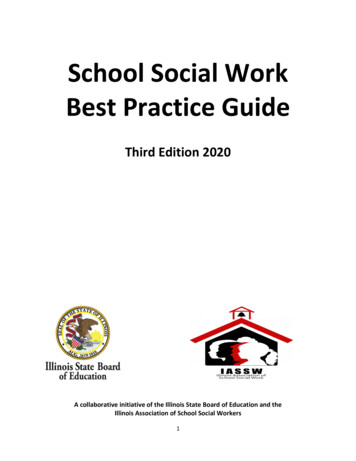
Transcription
School Social WorkBest Practice GuideThird Edition 2020A collaborative initiative of the Illinois State Board of Education and theIllinois Association of School Social Workers1
FOREWORDThe Illinois Association of School Social Workers (IASSW) believes that “School Social Workers (SSW) area vital part of the educational team, working together with educational administrators, teachers,counselors, psychologists, nurses, speech and language pathologists and other staff. Their uniquegraduate level training in social work enables them to understand and interpret the influences of theschool, home, and community on children. School Social Workers identify factors that can make school amore successful experience for students.” Within their roles, school social workers perform a variety oftasks and implement an array of supports to assist students, parents/guardians, schools, andcommunities.School social workers are vital in the implementation of the goals established by the Illinois State Boardof Education (ISBE). One of these goals is that “(a)ll districts and schools will receive the resourcesnecessary to create safe, healthy, and welcoming learning environments, and will be equipped to meetthe unique academic and social and emotional needs of each and every child.” School social workers helpcreate safe, healthy, and welcoming learning environments for all children while using their training asmental health professionals to address the social and emotional needs of all children.Another ISBE goal is that “(e)very child will make significant academic gains each year, increasing theirknowledge, skills, and opportunities so they graduate equipped to pursue a successful future, with thestate paying special attention to addressing historic inequities.” School social workers can play a criticalpart in addressing historic inequities in student learning through their advocacy role to facilitateprogrammatic and systemic change in response to the needs of students, families, and the school system.Recognizing the needs of diverse populations of learners and advocating on behalf of those students helpsto ensure full access to educational opportunities.ISBE has also established a goal to elevate educators by ensuring that “Illinois’ diverse student populationwill have educators who are prepared through multiple pathways and are supported in and celebratedfor their efforts to provide each and every child an education that meets their needs.” School socialworkers possess unique training and experiences among educators that enrich the educational systemand provide a critical perspective to ensure children receive an education that meets their needs.The purpose of this School Social Work Best Practice Guide is to provide school social workers withpractices and procedures that will assist them to better serve school communities. This guide is meant toserve as a valuable resource for school social workers with many years of experience, school socialworkers just beginning their professional practice, school social work interns, and administratorsthroughout the State of Illinois.The first edition of this guide was a manual published in 1983, and the immediate previous revision waspublished in 2007. In 2016, IASSW members requested to collaborate with ISBE to produce an updatedversion of this valuable guide. IASSW solicited volunteers to work on this current edition. The contributorswho were chosen (see next page) represent as diverse a group as possible, considering race, age, years ofexperience, geographic area, student population, grade level, university representation, andadministrative representation. ISBE and IASSW wish to thank all those who contributed their time andknowledge to develop this third edition of the School Social Work Best Practice Guide.2
Mark Conyer, MSWEditorPrincipal Education ConsultantIllinois State Board of EducationSpringfield, ILTom Tebbe, MA, MSW, LCSWEditorIASSW Executive DirectorNorthbrook, ILBrenda Lindsey, MSW, Ed.D., LCSWEditorTeaching Full ProfessorUniversity of Illinois at Urbana-ChampaignEmily Shayman, MSW, Ph.D.EditorAssistant ProfessorLewis University; Romeoville, ILStacy Colgan, MSW, M.Ed., LCSWProfessional Learning CoordinatorNSSEO; Mt. Prospect, ILKrystal Cox, MSW, LCSWLead School Social WorkerKankakee, ILAlexandra Fliess, MSW, LCSWSchool Social Worker,SD #211; Palatine, ILEmily Kath, MSW, LCSWSchool Social WorkerChannahon, ILKaren Kistler, MSW, LCSWSchool Social WorkerGalesburg, ILTiffany Nelson, DSW, LCSWSchool Social Work CoordinatorAurora University; Aurora, ILPatricia Pagan, MSW, M.Ed.School Social Work Administrator,SD 299; Chicago, ILValerie Sims-Rucker, MSW, M.Ed., LSWSchool Social WorkerSauk Village, ILDr. Kari Smith, MSW, MA, Ph.D.Director for Student ServicesElmwood Park, ILTaMia West, MSW, M.A. Ed.School Social Work AdministratorSD 299; Chicago, ILAngela R. Winters, MSW, Ed.D.School Social WorkerCalumet City, ILAdditional Contributors:Rhonda Peterson Dealey, DSW, LCSWAssistant Professor, MSW Program DirectorWashburn University, Topeka, KSWill Co. School District 92, Lockport, ILBridget Hills-Yoder, MSWSchool Social WorkerCary, ILPhil Koehl, MSW, LCSWIASSW Past PresidentHoffman Estates, IL3
TABLE OF CONTENTSForewordChapter 1: Role of the School Social WorkerThe School (Host) SettingWorkloadCaseload Versus WorkloadComponents and Variables of the RoleReferencesChapter 2: Ethics & Professional StandardsCode of EthicsConfidentialityConsent for ServicesDocumentationTechnologyFrequently Asked QuestionsCultural HumilityResourcesReferencesChapter 3: Approaches to Service DeliverySocial and Emotional LearningTrauma-informed practicesConsultation and CollaborationReferrals to Outside AgenciesCrisis InterventionIndividual and Group WorkIndividual Behavioral SupportFunctional Behavioral Assessment (FBA)Behavioral Intervention Plan (BIP)AdvocacyBringing It All togetherReferencesChapter 4: Data-Driven Practices within Multi-Tiered Systems of SupportEvolution of Response to Intervention and MTSSTier I: Needs Assessments and School Social WorkersTier II: Short-term InterventionsTier III: Intensive 22223232425252526263030313233
Data CollectionEvidence-based ProgrammingReferencesChapter 5: Special Education ServicesThe Social Developmental Study (SDS)Parent Consents to Evaluation/Re-EvaluationParent/Guardian InterviewStudent InterviewTeacher InterviewStudent Observation(s)Record Review for an Initial EvaluationRecord Review for Re-evaluationsAdaptive Behavior AssessmentRecommendations and SummaryBest Practices Social Assessment Checklist for School Social WorkersIndividualized Education Program (IEP)Goals and Objectives/BenchmarksTermination of School Social Work ServicesTransition ServicesFunctional Behavioral Assessments within Special EducationBehavioral Intervention Plans within Special EducationThird-Party BillingReferencesChapter 6: LegislationAbused and Neglected Child Reporting ActThe Americans with Disabilities Act of 1990Ann Marie’s LawThe Children’s Mental Health Act of 2003Confidentiality of Substance Use Disorder Patient RecordsErin’s LawEvery Student Succeeds ActThe Family Educational Rights and Privacy ActHealth Insurance Portability and Accountability Act of 1996Illinois Administrative Code- Title 23Illinois Mental Health and Developmental Disabilities CodeIllinois School CodeIllinois School Student Records ActThe Individuals with Disabilities Education ActThe McKinney-Vento Homeless Education Assistance Improvements Act of 749505050515151515252535353555556
Section 504 of the Rehabilitation Act of 1973Chapter 7: Licensure & SupervisionLicensureSupervisionTypes of SupervisionAdministrative Supervision[Professional] Peer SupervisionCollegial SupervisionResources and Information Regarding Licensure and SupervisionLSW and LCSWMaintaining a PEL: SSW & LSW/LCSWFeesProfessional Liability InsurancePEL: SSW Education Preparation ProgramsReferencesChapter 8: Special PopulationsUndocumented Students (“DREAMers”)Students Identifying as LGBTQIA Children from Military FamiliesChildren Experiencing HomelessnessChildren of Incarcerated ParentsYouth in Care (Students in Foster Care; Grandparents as Guardians; Kinship Care)Students who are Pregnant and/or ParentingReferencesAppendix A- School Social Work in Illinois: History of the ProfessionReferencesAppendix B: Duties of Mandated ReportersActions Taken by DCFS After Report FiledProtections for ReportersAppendix C: Professional Resources Relevant to School Social WorkersCouncil on Social Work EducationIllinois Association of School Social WorkersIllinois Department of Financial and Professional RegulationIllinois State Board of EducationNational Association of Social WorkersSchool Social Work Association of AmericaU.S. Department of 6868697072757677787979797980808181
CHAPTER 1ROLE OF THE SCHOOL SOCIAL WORKERWhat is our role as school social workers? We are often asked by other professionals, families, students,and other clients what we do exactly, so it is important that we are able to articulate the scope andbreadth of our role as a cohesive profession. Generally, school social workers are seen as the link betweenthe school, home, and community, although the role of school social workers has grown, changed, andadapted alongside generalist social work practices as well as the field of education.See Chapter 3: Approaches to Service Delivery about school social work within a Multi-Tiered System ofSupport (MTSS) for more specific information regarding service provision/delivery at various levels andpoints within the school system.School social work began as an intervention to support students within the school system for studentswhose backgrounds and/or personal lives created potential barriers for success in public education. Sincethe inception of the profession, school social workers have offered connections and resources betweenthe school and the community/home environment. The first school social workers (in the early 1900s)were considered “visiting teachers,” who provided families with community connections and resources.Since beginning with resource allocation and case management approaches, the role has grown andexpanded over time to include provision of mental health services to students. While changing legislationand shifting societal trends have continuously shaped the ever-changing role of school social workers,current school social workers are mental health practitioners who support students experiencing barriersto their educational success (Allen-Meares, 2006; 2013; Constable, 2016; Costin, 1978; Dupper, Rocha,Jackson, & Lodato, 2014; Frey et al., 2013; Kelly et al., 2016; Phillippo & Blosser, 2013).See Appendix A for further information about the history of the profession.The inevitable shifts, in both the needs of our students and the school environment, will continue to addvariation and ambiguity amongst school social work roles and practices. Regardless, school social workerssupport the educational setting with their unique knowledge base that lends to working within macrosettings (i.e. Tier I- districtwide, schoolwide); mezzo settings (i.e. Tier II- schoolwide, classroom); and microsettings (i.e. Tier III- individual, small groups). Working within a school setting allows opportunities forschool social workers to partake in various tasks and responsibilities across these tiers of support.The School (Host) SettingSocial workers are employed in a variety of settings. Some work in agencies specific to social work, suchas agencies that provide therapy or social services. Other social workers may work in host settings, or inplaces where social work is not the primary goal or intention of the workforce (Constable, 2016; Dane &Simon, 1991). There are social workers in hospitals, in the criminal justice system, in policymaking settings,and other settings. Then there are school social workers who are employed within the schoolsetting. Therefore, school social work practices occur in a host setting, where services are specialized tospecific needs and/or specific populations. In the case of a school, the general primary goal of the settingis to provide educational material to students.7
Overall, the school setting generally employs professionals seeking to disseminate academic knowledgeto students. School social workers work amid educational policies, educational jargon and terminology,and practice approaches related to teaching and learning. Therefore, in addition to the foundation ofsocial work knowledge, school social workers also learn and practice based on the influence of the fieldof education. School social workers are then able to advocate for and practice on behalf of the studentsand the school community while coming from a particular perspective that teachers and schooladministration may not have. As mental health practitioners, school social workers use their specializedcombination of knowledge from both the fields of social work and education to align their services toensure that all students can access the learning process and school environment to the best of their ability.School social workers provide differentiated services to students in the school, looking for and creatingopportunities to advocate for the whole child, including behavioral, social, and emotional needs.School social workers consistently collaborate with an interdisciplinary team of professionals; therefore,they may need to explain and discuss the scope and breadth of their role with their colleagues who donot immediately understand school social work goals and intentions. At the same time, there aredifferences that school social workers encompass within their role while working alongside andcollaborating with school staff. For example, as licensed social workers, school social workers must adhereto the National Association of Social Workers (NASW) Code of Ethics (2017).See Chapter 2: Ethics & Professional Standards for more information about school social work in relationto the NASW Code of Ethics.The school social work role will continue to grow and expand based on the strengths, needs, and demandsof school settings and mental health practices. Different host (school) settings have different resources,perspectives, and needs; therefore, the best practices of school social workers may change and flex basedon the presenting situation(s).WorkloadWhile the unique characteristics of working within a host setting contribute to the formation of the schoolsocial work role, there are many other variables that also add to the differences amongst practitioners’roles. The age and grade-level of student populations create differences in what is needed within schoolsocial work and how the needs are approached; the problems occurring in an elementary school are muchdifferent than that of a high school. Also, the contextual conditions of the school also contribute to thescope of the role of school social workers. For example, a rural school population will have differentcultural norms than would a school within the city limits of Chicago. The availability of social services andresources within one neighborhood area or another can also create different needs of the job for eachindividual practitioner. Furthermore, some schools may employ a school social worker full time and/orpart time, or one social worker may serve multiple school buildings (Dupper, et al.,2014; Franklin, Kim &Tripodi, 2009; Kelly, et al., 2015; Phillippo & Blosser, 2013).School districts and systems function and grow individually, developing unique policies and systems thatwork best for the specific setting and student communities they serve. Legislative demands of the city,state, and nation must all be considered when determining priorities of daily tasks and responsibilities(Gherardi, 2017; Kopels, 2016). Some social work activities fall into the category of mandated servicesthat are authorized and regulated by state and federal laws for provision of appropriate educationalservices to all students. Such mandated services include participating in early intervention student support8
committees, conducting assessments for students being evaluated for special education, providingservices defined by Individualized Education Programs (IEPs) and Section 504 Plans, and reportingsuspected child abuse. Additionally, school social workers are named in both federal and state statutes asconducting Functional Behavioral Assessments (FBAs) and developing positive behavior interventions.Some school social workers are employed exclusively to provide mandated services, thereby having littleopportunity to provide the other identified school social work functions, while others do very little in thearea of mandated services (especially if others are employed specifically to provide those services). Mostschool social workers, however, perform a blend of all functions with great variation in the relativeamounts of time devoted to each function (Kelly, et al., 2016). Other legislation warrants additionalpolicies and tasks for schools that could relate to services provided by school social workers. For example,laws about bullying and truancy demand that schools react in specific ways, and school administratorsmay ask that school social workers assist in these situations due to their professional knowledge andabilities as mental health professionals. All school social work functions can be provided at several levels,across the three tiers and levels of support (Allen-Meares, 2013; Constable, 2016).Because of the varying tasks and responsibilities that school social workers may encounter, definitivecaseload/workload allocations have not been determined for school social workers in Illinois.Clinician/student ratios are often determined based on financial capabilities of the school and/or district.Regardless of specific allocations, though, it is important for school social workers to distinguish theircaseload versus their workload (Kelly & Whitmore, 2019).Caseload Versus WorkloadWhile the term “caseload” refers to the specific number of students that a school social workerconsistently services, the term “workload” includes a more expansive, all-encompassing way to describeall the tasks and responsibilities school social workers may do (Kelly & Whitmore, 2019; Ward, et al.,2018). School social workers will have a caseload of students to whom they provide direct services basedon a student’s IEP. Each school social worker is able to compile the number of minutes spent providingtherapeutic support to these students. However, there is more to the work than simply these directservices, which lends to the discussion of overall workload.School social workers’ workloads are composed of much more than minutes of direct service delivery(Franklin, Kim & Tripodi, 2009). For example, school social workers provide collaborative, consultativeservices to teachers who are uncertain how to react/respond to their students. School social workers alsospend time completing evaluations and observations for students both within special education andgeneral education, including behavioral and social/emotional assessments. They respond to crisissituations, such as assessing the threat of student suicidality, supporting families experiencinghomelessness, and de-escalating difficult behavioral situations. School social workers also supportschoolwide programming, such as bullying intervention programs or behavioral regulation curricula.School social workers are always looking for community connections and finding ways to ensure culturallyresponsive and trauma-informed practices are applied throughout the school. Therefore, given this widearray of tasks, school social workers’ time allocation should not and cannot be determined based on acaseload alone (Kelly & Whitmore, 2019). Rather, school social workers must consider their generalworkload when discussing the work they do.9
When planning for the workday and determining priorities, school social workers must consider not onlythe time spent on direct services but also the time spent on the preparation and follow-up services theymust complete (Kelly, et al., 2016). Evaluations for special education, for example, take ample time in thatthey include time to complete not only the interviews with parents, teachers, and the student, but alsotime to write summaries of the interviews, observe the student, consult with other members of theevaluation team, etc. Furthermore, school social workers may provide classroom lessons, and thereforepreparation time for these lessons must be allocated within the workload. School social workers also haveto plan lessons given to small groups of children and then document student progress after thelesson/intervention is provided. While school social workers are not necessarily provided a scheduled“prep time” as teachers are, they must allocate such time within their schedule to ensure they have thenecessary planning time to effectively manage their workload.Some school social workers choose to participate in a “time-study,” which is a tool meant to record andanalyze the way an individual school social worker spends his or her time (Kelly & Whitmore, 2019). Theschool social worker documents how time is spent every 15 minutes that (s)he is working. Activities arecategorized to determine how much time is spent delivering mandated services (e.g., direct services tostudents in special education, evaluations, documentation, etc.); planning indirect services (e.g.,preparing for tasks or planning activities for students or groups but not providing direct face-to-faceservices); dealing with students on a caseload and those outside of a caseload; consulting with teachers,etc. While a time-study can be tedious to complete, it is meant to capture an example workloadthroughout random periods of time within the school year; it is not meant to be a continuous activitythroughout the year. The data from a time-study can be used to advocate for additional school socialworkers in a school building, to show school administrators how school social workers spend their time,and to help individual practitioners plan and prioritize their own work needs. Furthermore, because schoolsocial workers’ workloads may differ across school sites and/or job assignments, time-study tools allowfor specificity about one’s own role. For example, a school social worker serving multiple school buildingswill need to set aside time for travel between worksites; those working in expansive rural areas will needmore travel time than those working within one neighborhood.Components and Variables of the RoleThe following information is meant to provide examples of various work tasked to and taken on by schoolsocial workers. This illustrative but not exhaustive list provides examples and is not intended to defineevery activity that might be performed in any kind of setting but rather to give a descriptive picture of themany-faceted activities that are commonly included in the school social worker's role (Phillippo, et al.,2017).In addition to the factors of the host setting as described previously, here are some factors that couldaffect role formation:a) Numbers of students, buildings, and/or districts served.b) Age and/or grade level of students.c) Number of staff members in the building (e.g., number of teachers/staff served, number of schoolsocial workers and other school mental health professionals available, etc.).10
d) Types of concerns to be addressed (e.g., services for persons with disabilities; crisis intervention;case management services; consultation with teachers, administration, and/or parents;participation on school committees, etc.).e) Specific expertise of the school social worker.f) Combination of any or all the above.For the most effective utilization of available resources and best service provision, school social work staffshould be involved in designing the needs assessment, evaluating the results, and developing a plan forallocating staff/resources (Dupper, Rocha, Jackson & Lodata, 2014). School social workers typically knowtheir own strengths and weaknesses best, and they will ultimately be more enthusiastic about providingservices in difficult situations if they themselves participate in all the steps of the process. An importantfactor to consider relates to burnout and morale (Leyba, 2009). School social workers and their supervisorsmust explicitly remember the consequences of and work to prevent burnout; this can be done in manyways through personal activities outside of the workplace, but also by ensuring that school social workerscan participate in professionally satisfying tasks.Overall, school social workers will continue to advocate not only for students, families, and the schoolcommunity, but also for the worth and importance of the school social work profession.ReferencesAllen-Meares, P. (2006). One hundred years: A historical analysis of social work services in schools.School Social Work Journal, Special Issue, 24-43.Allen-Meares, P. (2013). Children and adolescents, populations and practice settings: School SocialWork. Encyclopedia of Social Work. e, R. (2016). The role of the school social worker. In Massat, C. R., Kelly, M. S., & Constable, R. T.(Eds.), School Social Work: Practice, Policy, and Research. (8th ed.). Lyceum Books: Chicago, 3-24.Costin, L. (1978). Social work services in schools: Historical perspectives and current directions.Continuing education series of the National Association of Social Workers. Washington: NationalAssociation of Social Workers.Dane, B. O. & Simon, B. (1991). Resident Guests: Social workers in host settings. Social Work 36(3),208-213.Dupper, D. R., Rocha, C., Jackson, R. F., & Lodato, G. A. (2014). Broadly trained but narrowly used?Factors that predict the performance of environmental versus individual tasks by school social workers.Children & Schools, 36(2), 71-77. doi:10.1093/cs/cdu004Franklin, C., Kim, J. S., & Tripodi, S. J. (2009). A meta-analysis of published school social work practicestudies. Research on Social Work Practice, 19(6), 667-677. doi:10.1177/104973150833022411
Frey, A. J., Alvarez, M. E., Dupper, D. R., Sabatino, C. A., Lindsey, B. C., Raines, J. C., Norris, M. A.(2013). School social work practice model. Retrieved from evalua-1Gherardi, S. A. (2017). Policy windows in school social work: History, practice implications, and newdirections. School Social Work Journal, 42(1), 37Kelly, M. S., Frey, A., Thompson, A., Klemp, H., Alvarez, M., & Berzin, S. C. (2016). Assessing the nationalschool social work practice model: Findings from the second national school social work survey. SocialWork, 61(1), 17.Kelly, M. & Whitmore, S. (2019). It’s about time: Initial findings from a feasibility study of a time-studytool for Michigan. International Journal of School Social Work (4)1, 1-3.Kopels, S. (2016). Ethical and legal complexities of confidentiality for school social workers in schools. InMassat, C.R., Constable, R. & Kelly, M. (Eds). School Social Work: Practice, Policy & Research. (8th ed.).Chicago: Lyceum. 108-132.Leyba, E. G. (2009). Tools to reduce overload in the school social worker role. Children & Schools, 31(4),219-228.Phillippo, K. L., & Blosser, A. (2013). Specialty practice or interstitial practice? A reconsideration ofschool social work's past and present. Children & Schools, 35(1), 19-31. doi:10.1093/cs/cds039Phillippo, K. L., Kelly, M. S., Shayman, E., & Frey, A. (2017). School social worker practice decisions: Theimpact of professional models, training, and school context. Families in Society, 98(4), 275-283.Ward, J., Amin, A., Harrison, K., & Harrison, R. (2018). The utilization of an electronic data collectionsystem to assess professional practice in school social work. School Social Work Journal, 42(2), 1.12
CHAPTER 2ETHICS & PROFESSIONAL STANDARDSAs providers of mental health services to children in schools, school social workers will face difficult and/orethical dilemmas time and time again, so it is of utmost importance to be familiar and comfortable withthe National Association of Social Workers (NASW) Code of Ethics (see Resources section at end ofchapter), confidentiality laws, technology policies, and the concept of cultural humility.Code of EthicsAs mental health clinicians, the NASW Code of Ethics is the primary ethical guidance for social workers,including school social workers; however, social workers may also use ethical standards from other relatedprofessions for ethical guidance. Additional guidance for school social workers is described below.The Supplemental Ethical Standards for School Social Work Practice were developed under the leadershipof the Midwest School Social Work Council and adopted by the School Social Work Association of America.These standards build and extend upon the values, principles, and ethical standards articulated in theNASW Code of Ethics. Additionally, they specifically address issues critical to school social work practicebut not addressed in the NASW Code of Ethics. The standards are in addition to and do not in any waysupplant the NASW Code of Ethics.As mental health providers, school social workers should avoid presuming that requests of attorneys,courts, or government agencies, such as the Illinois Department of Children and Family Services (DCFS),are sufficient reason to breach confidentiality (Raines, 2016; Reamer, 2005). When faced with dilemmassurrounding disclosure of information, school social workers must consult with knowledgeable colleagues,legal representation, and/or their state association or licensing body. Often, dilemmas between disclosinginformation and protecting privacy can be m
to students. School social workers work amid educational policies, educational jargon and terminology, and practice approaches related to teaching and learning. Therefore, in addition to the foundation of social work knowledge, school social workers also learn and practice
